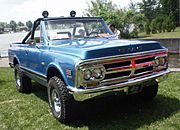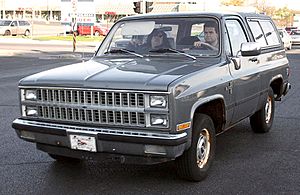Chevrolet K5 Blazer facts for kids

The K5 Blazer was a popular SUV made by Chevrolet. It was part of the bigger C/K Truck family. The K5 Blazer first came out in 1969. It was known for being a tough vehicle that could go off-road but also had features usually found in cars. In 1970, GMC made its own version called the Jimmy. Both the Blazer and Jimmy were based on short wheelbase trucks. You could get them with either rear-wheel drive (power to the back wheels) or four-wheel drive (power to all four wheels).
From 1969 until 1975, the K5 Blazer and Jimmy had a "full convertible" top that you could take off. After 1976, they changed to a "half-cab" design. This new design was safer and less likely to leak. It had a removable top section that started behind the front doors and went all the way to the back.
Contents
First Generation (1969–1972)
When the K5 Blazer first appeared in 1969, it was only available with four-wheel drive. But in 1970, Chevrolet also offered a two-wheel-drive model. Buyers had a choice of four different engines:
- Two straight-6 engines (250 cubic inches and 292 cubic inches)
- Two V8 engines (307 cubic inches and 350 cubic inches)
The Blazer was created to compete with other popular off-road vehicles like the International Harvester Scout and the Ford Bronco. These vehicles were smaller than most trucks. The Blazer was special because it was a shortened pickup truck. This gave it more space inside. It also helped keep production costs low because it shared parts with other trucks.
The Blazer quickly became very popular. It combined the off-road ability of vehicles like the Scout with "luxury" features. These features included things like air conditioning and automatic transmissions, which were usually only found in regular cars back then. By 1970, the Blazer was already selling more than its rivals. Other companies like Jeep (with the Cherokee) and Dodge (with the Dodge Ramcharger) soon made similar models. Ford didn't have a direct competitor until 1978.
The two-wheel-drive Blazer had a special front suspension that allowed wheels to move independently. It also had coil springs in the back. The four-wheel-drive version used a strong solid front axle and leaf springs on both the front and back. All Blazers used drum brakes on all four wheels until 1971. After that, all GM light trucks got front disc brakes as a standard feature.
You could choose from different transmissions:
- A three-speed automatic transmission (TH350)
- A three-speed manual transmission
- A four-speed manual transmission (SM465)
The Blazer also had good ground clearance (8 inches or about 20 cm). This meant it could easily drive over bumps and rough terrain.
Second Generation (1973–1991)
In 1973, GM completely designed and updated its full-size trucks, including the K5 Blazer. A tilt-steering wheel became an option, making it easier for drivers to get comfortable. While two-wheel-drive Blazers were made until 1982, most of the Blazers sold during this time were four-wheel drive.
As mentioned before, the K5 Blazer had a fully removable top until 1975. In 1976, GM introduced the "half-cab" design. This design was used until 1991.
Even though GM introduced a newer truck platform (called GMT400) in 1987, the K5 Blazer, Suburban, and crew-cab trucks kept their older design until 1991. In 1989, the front grille of the K5 Blazer was updated to look like the newer GMT400 pickup trucks.
The K5 Blazer was available with several engine choices during this generation:
- Different V8 "small block" engines (305ci, 307ci, 350ci, and 400ci)
- A 250ci Inline-6 engine
- A 6.2L Detroit Diesel engine
For better fuel economy, some second-generation Blazers used the smaller 305 V8 engine. After 1987, when throttle-body injection was added to truck engines, the 350 V8 became the standard engine.
M1009 CUCV (Military Version)
Around 1981, a special K5 Blazer was tested for military use. From 1983 to 1987, a military version called the M1009 CUCV was produced. CUCV stands for "Commercial Utility Cargo Vehicle."
The military M1009 CUCV Blazers had some key differences from the civilian models:
- They did not have air conditioning.
- They had an extra leaf spring in the suspension for more strength.
- Instead of a normal 12-volt car battery, they used a special 12/24-volt electrical system.
- They had blackout headlights for stealth.
- They featured a front-mounted brush guard and a rifle rack inside.
- They were painted in military colors, mostly olive drab green or woodland camouflage. Some used in the desert were painted tan.
- All M1009s were powered by the 6.2 L Diesel engine.
After their military service, many M1009s were sold through government auctions. Some were even used by law enforcement agencies, like the Los Angeles County Sheriff's Department. A few are still used by the National Guard today.
Images for kids









